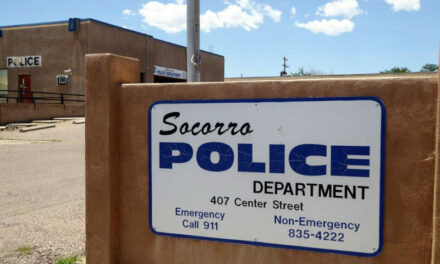
The Eagle Picher building has been fenced off from the public.
John Larson | El Defensor Chieftain
For the last 15 years, residents of Socorro and city officials have been voicing their concerns over toxic groundwater originating from the manufactural waste from the Eagle Picher Carefree Battery plant. Now a special advisory group has been formed to better facilitate communication between concerned citizens and the Environmental Protect Agency, which designated Eagle Picher as a superfund site.
The Socorro Eagle Picher Superfund Community Advisory Group, founded by Cheri Lerew, Vicki Kelsey and Rebe Feraldi, held its first meeting on Nov. 9.
Feraldi said the formation of such community advisory groups is deemed essential by the EPA.
“The purpose of the group is to facilitate getting information from the EPA to the community about the superfund site and then from the community back to the EPA,” Feraldi said. “What the EPA found from prior situations is that if you have that information flow, it actually allows the EPA to create better remediation and cleanup designs. Mainly because local people have information and concerns that are specific to the community.”
In 1964, Eagle Picher acquired the property from the city to begin manufacturing products like printed circuit boards until 1976. Those circuit boards were washed with chlorinated solvents. According to federal documents, the wastewater would spill into the floor drains and then to unlined lagoons on the property.
The city then used the site for a landfill until the company came back in 1980. Manufacturing non-automotive lead-acid batteries until the late 1990s.
Starting in 2000, the building and approximately 11 acres on the east side of the property were leased by Ty Zimmerman for his New Ventures motocross track, but in 2006 a flood swept through the building and track, which exposed lead battery plates and straps. As a result, the motocross site posed a health risk and ceased operation.
The lead-impacted surface soils were mainly limited to the southeast of the Eagle Picher manufacturing building and within the former wastewater impoundments.
At the present time, an underground plume of 1,4 Dioxane, TCE and PCE extends over 9,000 feet in length, from just south of the Eagle Picher site to the northern part of the New Mexico Tech golf course.
In February 2020 the EPA was testing for vapor intrusion due to groundwater contamination from the site, which encompasses two large traces totaling about 55 acres located along Interstate 25, about one-to-two miles north of Socorro. Eagle Picher was designated a superfund site in 2012 after a full round of sampling of about 38 irrigation, private domestic, municipal and monitoring wells, conducted by the New Mexico Environmental Department in 2010.
Based on the results of numerous samplings conducted from 1998 through 2012, the NMED initiated a Remedial Investigation and Feasibility Study to further characterize the nature and extent of contamination and to evaluate remedial alternatives for the site. The RI concluded that the site contained limited areas of soil contamination and extensive groundwater contamination.
At a town hall style meeting at Finley Gym in 2019, EPA officials said it might take up to 30 years and $16 million to clean up the Eagle Picher Superfund Site. And currently, the EPA has only $700,000 in its coffers designated for Eagle Picher. Congress decides how much money the EPA will receive. Once that amount is determined it is divided among 10 EPA regions across the United States. Once the money is approved it’s up to a priority panel of program experts to evaluate the risk with respect to human health and the environment. The agency uses these evaluations to establish funding priorities for all new cleanup construction projects in the Superfund program. The approach allows each region to list its priority projects and rank these projects against priority projects from other regions, ensuring that scarce resources are allocated to the projects posing the most risk to human health and the environment.
The plan for the cleanup of the Eagle Picher Superfund Site involves five phases:
- Evacuate soil from the Eagle Picher site and dispose of it off-site. Clean-up activities will involve excavating contaminated soils from the wastewater impoundment area, near the west entrance of the manufacturing building, near the southwest of the manufacturing building. Approximately 1,000 cubic yards of soil will be removed from the site.
- Remove construction debris from the Eagle Picher site and dispose of it off-site. Cleanup activities will involve removing construction debris containing asbestos-containing building material and lead-based paint.
- Phased focused pump and treat groundwater. Cleanup activities involve implementing a Phased Pump and Treat remedy to restore groundwater. Performance monitoring will be conducted throughout the active treatment period.
- Active containment of vapor instruction. Installing an active containment system of the soil gases, depending on building construction either sub-slab depressurization, for homes constructed directly on foundations or crawl space depressurization, for homes built using pier and beam (open space beneath) construction. Either method will be used to actively remove soil gas prior to its migration to indoor.
Soil gases have not been determined. At the present time, cleanup activities for soil gases have not been identified and are part of the EPA’s current ongoing optimization study.
Feraldi invites all community members to join the advisory group.
“The meetings are to garner support and leverage this EPA service to keep the information flowing into the community and back from the community to the EPA,” Feraldi said Monday. “There are many details to be worked out and volunteers, board members, local officials, and the general public are all welcome to participate.”
Meetings will be held on the second Thursday of the month and will be virtual until further notice.
“It’s unfortunate that it has to be virtual,” Feraldi said. “In fact, the EPA really didn’t want to do it that way, and they don’t have precedent for that. Federal legislation says that a community advisory group should be set up in person in the community so that all community members have access to all of the information.
“So we’re in this unprecedented situation with COVID and we’re under a lot of pressure to just get this going,” she said.
The next meeting is Thursday, Dec. 9 from 6:30-8 p.m. and will be virtual, but Feraldi said future meetings may be in hybrid form.
More information and links can be found on the group’s Facebook page, Socorro NM Eagle Picher Superfund site.



















